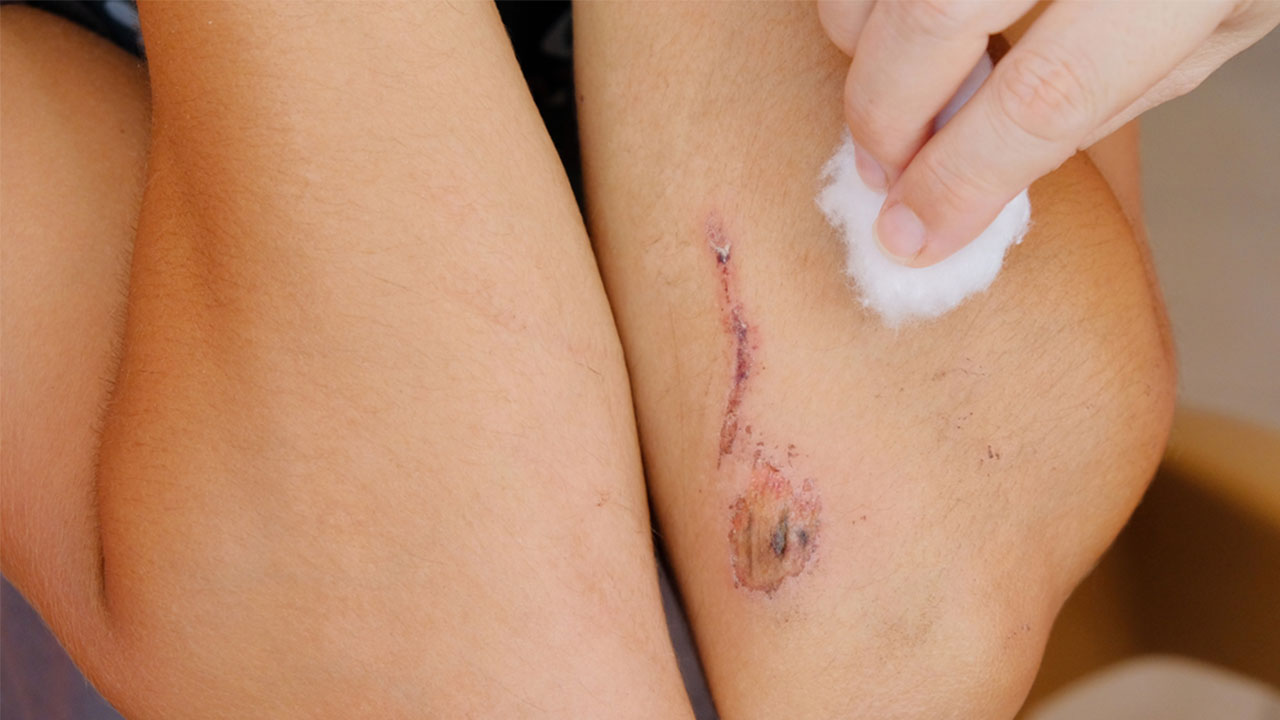How to Speed up Healing: From Sunburns to Surgery Recovery
 By: by Amino Science
By: by Amino Science

Whether you have a cut, a burn, or are healing from a surgical procedure, there are ways to help speed up healing and close your wounds faster. The wound healing process, much like our physical activity levels, tends to decline as we age. The older we get, the longer our healing time takes, leading in some instances to chronic wounds that never really go away. To speed up wound repair, here are some tips for helping your body along.

At-Home Healing: Small Wounds and Scar Reduction
When it comes to home remedies for wound care, there are a lot of old wives' tales still around. Some of them make a certain amount of sense when considered scientifically, like waiting 30 minutes to swim after you eat may well help you avoid a minor cramp. However, not all of these folktales are true enough to keep repeating or insisting on. Not everyone will get a minor cramp if they swim after eating, and even if they do, it won't cause them to drown. And yet still we wait, and tell children to wait, and keep the myth going.
When it comes to how to speed up wound healing, there are a lot of practices that don't really apply. Some say leaving a wound open to dry in the air and "breathe" helps it heal faster, but that isn't true if it's now open to dirt and possible infection. To stop infection, many douse a wound in alcohol or peroxide—talk about pouring salt on a wound!
In truth, leaving a wound to dry out is not ideal, and can even slow healing and increase pain. Wounds need moisture to heal, and moist wound healing speeds up healing and reduces scarring. Here are some other tips on how to foster faster healing and reduce the risk of scarring.
1. Clean and Disinfect
Before touching a wound, wash your hands. When it comes to cleaning the wound, start with clear water and a clean cloth to remove any dirt or particles from the wound. If there are pieces of debris in a wound (your kid took a wipeout on their skateboard and has gravel embedded in the scrape, for example), use a pair of tweezers to remove them. The tweezers should be sterilized with some isopropyl alcohol, but alcohol is not advised directly on the open wound.
Instead, once the wound is clean, apply an antibiotic cream, ointment, or spray to the wound area, and make your call about what kind of bandage applies. If it's an open wound like a wide scrape, a gauze and a wrap may be called for, but a cut on a finger might need only a bandaid to reduce the risk of infection and speed healing.
Remember not to pick at any scab that forms, because a scab is the body's natural bandage.
2. Encourage Blood Flow
Nobody can heal you better than your own body, but there are ways to help it along. You'll notice when you get a scrape or a bruise that the area seems to heat up. That's because the body has dispatched its in-house medical team via your bloodstream.
To increase blood flow to the skin and surrounding area, you can apply a heating pad or hot water bottle, or place the wound area in some warm water for 15-30 minutes. It's not a high-tech method but it does help, especially for wounds on your extremities (fingers, toes, arms, and legs) where your blood vessels are smaller, or for anyone with poor circulation, like the elderly.
If adding heat is uncomfortable, massaging the surrounding area is another way to usher blood to the site of injury.
3. Reduce Inflammation
After encouraging healthy blood flow, your wound may experience unhealthy inflammation. A burn that you got from pulling dinner out of the oven might feel like it's still burning for days after, and you'll want some kind of anti-inflammatory to help relieve the pain.
Many people think of the gel-like insides of the aloe vera plant for burns, and this is an age-old home remedy that actually works! Aloe vera is a succulent plant originally native to Africa that has a gooey substance in its leaves called mucilaginous juice, and while the plant is 99% water, it does have two chemicals within that improve wound healing.
According to researchers, many of the healing effects of aloe vera are due to the glycoproteins and polysaccharides present in the plant's pulp. The polysaccharides increase cellular movement, leading to faster tissue regrowth, and the glycoproteins help relieve pain and control the inflammatory response. Together these compounds aid and possibly improve your immune system.
There is even more evidence out of a 2015 study that suggests there are further helpful compounds in aloe vera for cutaneous wounds (like sunburns). For instance, glucomannan stimulates the growth of fibroblasts responsible for collagen, skin cell, and tissue building. Other chemicals found in aloe vera may also help foster blood vessel regrowth, making it a fantastic, natural anti-inflammatory to have on hand for minor wound healing.
4. Get More Protein, Vitamins, and Nutrients
There are certain power foods that contain the nutrients your body needs to rebuild itself, including vitamin C, vitamin D, vitamin E, omega-3 fatty acids, and magnesium. You'll find these nutrients in dark green leafy vegetables and in orange, yellow, and red fruits and veggies (eat the rainbow!), like bell peppers, tomatoes, oranges, and more.
One of the biggest factors when it comes to tissue and wound healing though? Protein. Omega-3s come from fish along with fish's protein content, and you can get an assortment of your essential amino acids from various meats and dairy products.
Amino acids are needed for wound healing, so if you're not a meat-eater, you can increase your protein intake with certain vegetarian and vegan protein foods, or with an amino acid supplement while you heal. Life is a vegan blend of amino acids that can help build muscle and accelerate recovery.
How to Speed up Healing After Surgery
Outside of household and playground injuries, recovery after surgery is a whole different ball game. No matter where it is on the body or how good the chances for a speedy recovery are, surgery still carries a certain amount of risk, and so does surgical recovery. Once you're sent home from your procedure, you're going to want to heal as quickly and safely as possible. Here are some tips for how to do so.
1. Follow Your Doctor's Instructions
While it's true that no one knows your body quite like you do, doctors don't give out suggestions willy-nilly. Their medical advice is based on data and research collected from all different kinds of patients over years and years of procedures.
If a doctor tells you to avoid activities for a specific amount of time after a procedure, it's in your best interest to heed that advice. If you're told to avoid driving, avoid sexual intercourse, avoid alcohol, or avoid lifting anything over 10 pounds for a couple of weeks, this is for your safety, and so you don't end up back in their office with a new injury or complication. You may be feeling good enough to return to normal activity, and that's great, it means your healing is right on course! And yet there may still be healing processes going on beneath your skin that need a little bit more time.
2. Eat the Right Recovery Foods
As true as it was for minor wounds, eating a nutrient-dense diet is even more important after a surgery, because you're healing much deeper wounds. Although you may have a loss of appetite or digestive discomfort after a surgery, it's important that you eat a healthy diet by any means necessary (broths, smoothies, amino acid powders), because certain foods are actually going to feed your recovery process.
Again, vitamin C and zinc can help with healing, and can be had from fruit and beans. Iron and vitamin B12 help in forming new blood cells and can be found in fish and eggs. Sports and sugary drinks should be avoided for the time being, as should refined sugar foods.
Protein is more important than ever, as many surgeries by nature involve cutting through tissue and muscle, and the amino acids in protein can help speed post-surgical recovery. Meat, poultry, fish, and eggs are all strong sources of protein, but if a doctor tells you to take a protein supplement, look for a comprehensive amino acid supplement. For recovering after surgery, you may need more protein than a normal diet or your appetite can provide, and supplementing may be a necessity.
Heal is a specially formulated blend of amino acids proven to help reduce recovery times and improve physical function after surgery and injuries by accelerating muscle repair while helping to maintain a healthy inflammatory response. Click here to learn more.
3. Follow-up, Ask For Help, and Get Moving Gradually
Surgical recovery may take a while and involve follow-up appointments, physical therapy, and/or at-home assistance. During this time, it's important to keep all appointments with your health care team, because a diagnostic such as bloodwork could alert your doctor to a problem before it becomes an infection. Likewise, physical therapy could help you correct something like a limp before it becomes a misalignment.
Asking for help from your family or your medical team may not be your usual tendency, but it is necessary and encouraged for the sake of a speedy and successful recovery. If problems are allowed to fester, you could end up back in the hospital or on bedrest, and in danger of new problems altogether, like muscle atrophy.
4. Don't Smoke
This is a tip that may not apply to all, so if you don't smoke or have never smoked, skip ahead. However, if you are a smoker or live with one, the effects of cigarette smoking can counteract your wound healing.
Nicotine tightens blood vessels, and the more constricted your blood vessels are, the harder it is for all the other recovery work you're doing to matter. The nutrients you eat won't be going to the right places, the muscle you're building takes longer to thrive, your wounds take longer to heal, and more carcinogens and harmful substances are coming in at the same time. If you've ever wanted to quit smoking, after a surgery it's more important than ever, and can make even more of a positive health impact.
The Need for Speed
Some things can't be rushed, and a lot of the time your health is the tortoise racing against the hare: slow and steady wins the race. Diet and exercise are long-haul habits that make all the difference. While that's also true when it comes to a lot of aspects of healing, the more you can do to support your body's healing mechanisms and get out of their way, the faster the process goes and the lower the chance you'll have any more problems arising from the initial issue.
Whether it's a cut, a sunburn, a broken limb, or a surgical operation, anything can go from bad to worse if you're not careful. Luckily there are resources you can use and advice to be had on how to speed up healing in a successful and sustainable way. Take these tips into consideration, seek medical advice if needed, and know that we wish you a speedy recovery.

Up to 25% off Amino
Shop NowComments (0)
Most Craveable Recipes




 833-264-6620
833-264-6620



















